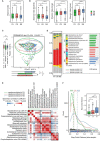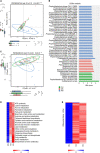Shotgun metagenomic sequencing reveals skin microbial variability from different facial sites
- PMID: 35966676
- PMCID: PMC9364038
- DOI: 10.3389/fmicb.2022.933189
Shotgun metagenomic sequencing reveals skin microbial variability from different facial sites
Abstract
Biogeography (body site) is known to be one of the main factors influencing the composition of the skin microbial community. However, site-associated microbial variability at a fine-scale level was not well-characterized since there was a lack of high-resolution recognition of facial microbiota across kingdoms by shotgun metagenomic sequencing. To investigate the explicit microbial variance in the human face, 822 shotgun metagenomic sequencing data from Han Chinese recently published by our group, in combination with 97 North American samples from NIH Human Microbiome Project (HMP), were reassessed. Metagenomic profiling of bacteria, fungi, and bacteriophages, as well as enriched function modules from three facial sites (forehead, cheek, and the back of the nose), was analyzed. The results revealed that skin microbial features were more alike in the forehead and cheek while varied from the back of the nose in terms of taxonomy and functionality. Analysis based on biogeographic theories suggested that neutral drift with niche selection from the host could possibly give rise to the variations. Of note, the abundance of porphyrin-producing species, i.e., Cutibacterium acnes, Cutibacterium avidum, Cutibacterium granulosum, and Cutibacterium namnetense, was all the highest in the back of the nose compared with the forehead/cheek, which was consistent with the highest porphyrin level on the nose in our population. Sequentially, the site-associated microbiome variance was confirmed in American populations; however, it was not entirely consistent. Furthermore, our data revealed correlation patterns between Propionibacterium acnes bacteriophages with genus Cutibacterium at different facial sites in both populations; however, C. acnes exhibited a distinct correlation with P. acnes bacteriophages in Americans/Chinese. Taken together, in this study, we explored the fine-scale facial site-associated changes in the skin microbiome and provided insight into the ecological processes underlying facial microbial variations.
Keywords: Chinese; Cutibacterium acnes (C. acnes); Propionibacterium acnes bacteriophage; biogeography; facial skin microbiome; fine-scale; shotgun metagenomic sequencing.
Copyright © 2022 Wei, Li, Gu, Liu, Krutmann, Wang and Xia.
Conflict of interest statement
The authors declare that the research was conducted in the absence of any commercial or financial relationships that could be construed as a potential conflict of interest.
Figures




References
LinkOut - more resources
Full Text Sources

